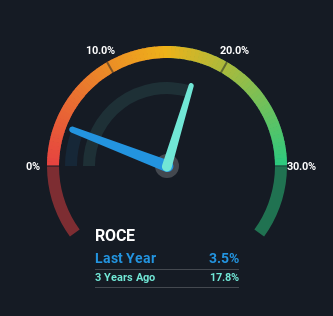
If you're not sure where to start when looking for the next multi-bagger, there are a few key trends you should keep an eye out for. Firstly, we'd want to identify a growing return on capital employed (ROCE) and then alongside that, an ever-increasing base of capital employed. Basically this means that a company has profitable initiatives that it can continue to reinvest in, which is a trait of a compounding machine. In light of that, when we looked at Novac (TSE:5079) and its ROCE trend, we weren't exactly thrilled.
Return On Capital Employed (ROCE): What Is It?
For those that aren't sure what ROCE is, it measures the amount of pre-tax profits a company can generate from the capital employed in its business. Analysts use this formula to calculate it for Novac:
Return on Capital Employed = Earnings Before Interest and Tax (EBIT) ÷ (Total Assets - Current Liabilities)
0.035 = JP¥650m ÷ (JP¥32b - JP¥13b) (Based on the trailing twelve months to January 2024).
Thus, Novac has an ROCE of 3.5%. In absolute terms, that's a low return and it also under-performs the Construction industry average of 7.6%.
View our latest analysis for Novac

Historical performance is a great place to start when researching a stock so above you can see the gauge for Novac's ROCE against it's prior returns. If you're interested in investigating Novac's past further, check out this free graph covering Novac's past earnings, revenue and cash flow.
The Trend Of ROCE
When we looked at the ROCE trend at Novac, we didn't gain much confidence. Around three years ago the returns on capital were 18%, but since then they've fallen to 3.5%. On the other hand, the company has been employing more capital without a corresponding improvement in sales in the last year, which could suggest these investments are longer term plays. It's worth keeping an eye on the company's earnings from here on to see if these investments do end up contributing to the bottom line.
On a separate but related note, it's important to know that Novac has a current liabilities to total assets ratio of 41%, which we'd consider pretty high. This can bring about some risks because the company is basically operating with a rather large reliance on its suppliers or other sorts of short-term creditors. Ideally we'd like to see this reduce as that would mean fewer obligations bearing risks.
What We Can Learn From Novac's ROCE
To conclude, we've found that Novac is reinvesting in the business, but returns have been falling. Since the stock has gained an impressive 25% over the last year, investors must think there's better things to come. However, unless these underlying trends turn more positive, we wouldn't get our hopes up too high.
Novac does come with some risks though, we found 2 warning signs in our investment analysis, and 1 of those is potentially serious...
For those who like to invest in solid companies, check out this free list of companies with solid balance sheets and high returns on equity.
Valuation is complex, but we're here to simplify it.
Discover if Novac might be undervalued or overvalued with our detailed analysis, featuring fair value estimates, potential risks, dividends, insider trades, and its financial condition.
Access Free AnalysisHave feedback on this article? Concerned about the content? Get in touch with us directly. Alternatively, email editorial-team (at) simplywallst.com.
This article by Simply Wall St is general in nature. We provide commentary based on historical data and analyst forecasts only using an unbiased methodology and our articles are not intended to be financial advice. It does not constitute a recommendation to buy or sell any stock, and does not take account of your objectives, or your financial situation. We aim to bring you long-term focused analysis driven by fundamental data. Note that our analysis may not factor in the latest price-sensitive company announcements or qualitative material. Simply Wall St has no position in any stocks mentioned.
About TSE:5079
Novac
Operates in the civil engineering and construction general contracting business in Japan.
Adequate balance sheet low.
Market Insights
Community Narratives




